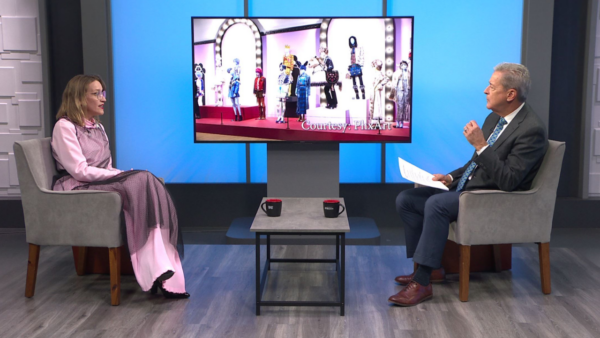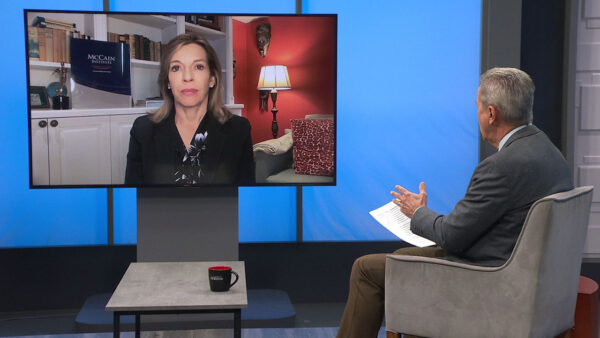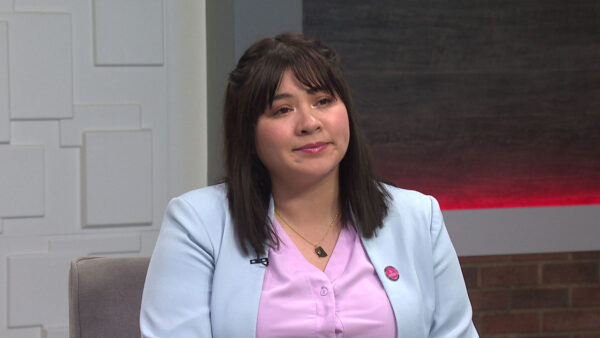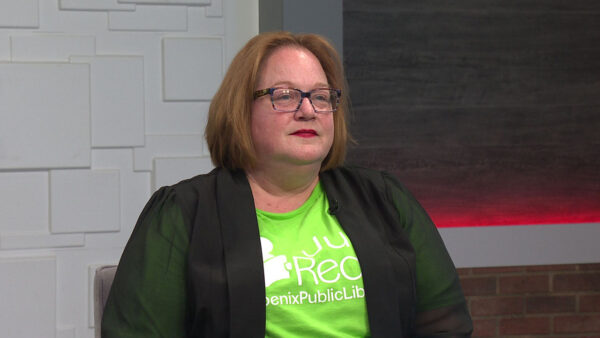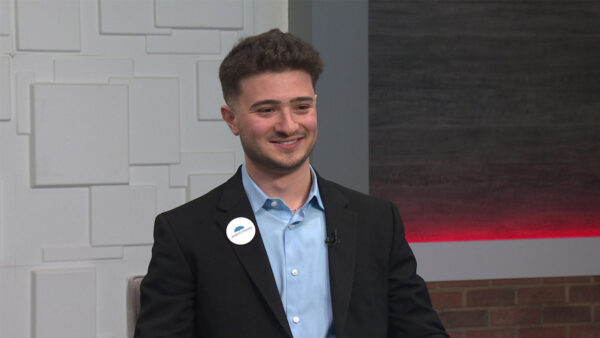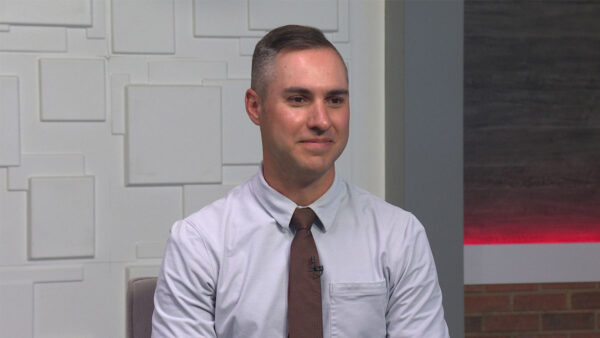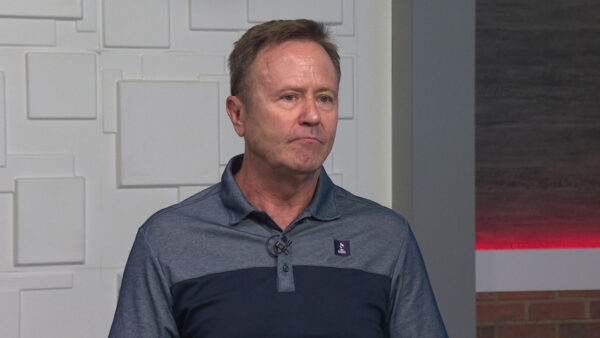For more than 70 days now, the Valley has had no rain. National Weather Service Meteorologist Tony Haffer will talk about the drought and why it’s happening. Kirk Rowdabaugh of the State Land Department will talk about the drought’s impact to help provide fuel for wild fires.
Michael Grant:
Tonight on Horizon, it's been almost three months since rain fell in the valley. This is the time of year we're supposed to be getting some. That's going to make for a much worse fire season. Also tonight why emergency rooms are being flooded with patients. We'll tell you more about that. That's next on Horizon.
Announcer:
Horizon is made possible by the friends of channel 8. Members who provide financial support to this Arizona PBS station. Thank you.
Michael Grant:
Good evening and welcome to Horizon. I'm Michael Grant. Before we get to the main topics tonight here's a development from today. Arizona's Chief Justice announcing an effort to speed up processing of drunk driving cases. Ruth McGregor announced the formation of pilot courts in metro and rural jurisdictions. The goal is to get the pilot courts to process 90% of DUI cases in 120 days, 98% in 180 days. Those recommendations based on findings from a statewide DUI case processing committee.
Today is the 79th day without rain in the valley. And in many parts of Arizona the last time it rained was October 17. Compare that to last year when the valley had shall we call it an overabundance of rain. Here to talk about the lack of rain is Tony Haffer. He's a meteorologist with the national bureau of the weather service. Also Kirk Rowdabaugh. We don't always get together during fire season.
Kirk Rowdabaugh:
That's correct. No smoke today.
Michael Grant:
That's right. Well, let's start with rain. Tony, we ain't got none. What's going on?
Tony Haffer:
Well, what we've had is an unusually dry period because of the high-pressure area that's kind of parked itself over the southwestern United States and has pushed the storm track to our north. Of course we've seen the coverage of the floods in northern California and the Pacific Northwest has been getting all the moisture while we've been sitting down here high and dry.
Michael Grant:
Do we know why a high-pressure system will park? What phenomena lead to that?
Tony Haffer:
Well, the atmosphere as a whole is influenced by the oceans and the temperatures, the difference in temperatures across the surface of the oceans -- what's been happening in the eastern pacific is the proverbial la Nina which for us means we're going to have a dry winter. It's been increasing in strength, although still very weak. Its influence on jet streams and the moisture patterns that effect North America has been such that all of the moisture has been shunted towards the north and the southern half and in particular we in the southwest have not seen any moisture or storms at all.
Michael Grant:
Isn't there a standard pattern in the winter the storms coming down from the gulf of Alaska and if we're lucky taking a sharp left turn at Los Angeles and San Diego and then coming across the state? Is that the normal pattern?
Tony Haffer:
Absolutely, yes. That's the typical pattern. Storms come down the west coast and move across the southern tier states. Generally we have some moisture and rain and snow in higher elevations. But this year this blocking high-pressure area has shunted everything to the north. That's why we've seen basically nothing since the middle of October.
Michael Grant:
I think the other unusual aspects about this is it's been statewide. Occasionally even phoenix and Tucson are dry. You'd still be getting some precipitation in the northern third of the state.
Tony Haffer:
Certainly the case. It's very important. We were looking at some data today and the NRCS which manages and measures the snow that generally falls across the united states and in particular in the western united states has reported that 94% of the sights that they measure snow have no snow, zero, bare ground as of January 1. That's the only time or the most number of sites in the last 40 years with no snow this time of year.
Michael Grant:
You were telling me if it goes another 10 days?
Tony Haffer:
Yes. If it continues which it looks like it will, no snow in higher elevations that by mid January should that still be the case with 94% of the snow tell sites and the other sites they measure snow at with no snow that will be the worst in the history of Arizona for there to be such a widespread area of no snow in Arizona.
Michael Grant:
Kirk, no rain. I would assume it's got to be bone dry out there in terms of fire conditions.
Kirk Rowdabaugh:
Yeah. Already. I mean, the truth is we won't know what this fire season looks like until we get to this fire season. It will depend on the ignition patterns and the weather that occurs on the day that firefighters start. But the indicators, the long-term weather projections and the known consequences of the recent weather on our fire fuels all point to a potentially very severe fire season. As Tony mentioned there's no snow on the ground. What should be happening this time of the year is that the large forest fuel should be absorbing a lot of moisture right now and in setting themselves up for what would normally be the drying trend, may, June, July and august. But they've been losing moisture since the end of the monsoon season. They're losing moisture right now. As soon as it starts to warm up significantly in march going to be very, very dry, very, very early this fire season. Fine fuels, the fuels that actually carry the flames, we're doing a little better in the desert this year. We're not expecting a lot of new growth. Unfortunately the weather has been so mild this winter that fine fuels that grew last winter that didn't burn last summer are still largely available to burn next summer.
Michael Grant:
Because they didn't get killed off by very cold weather.
Kirk Rowdabaugh:
Yes. I mean, typically you'd have snow and rain and wind and lousy weather that would break those fuels down over the course of a normal winter. Right now standing tall and proud and brown just like they were at the end of last summer. And unless the weather significantly changes they're going to still be tall and brown and ready to burn come March. So potentially we're looking not only at a very severe fire season but an early one, March instead of May.
Michael Grant:
So that sort of negates the positive impact -- there's the good news story and the bad news story -- the good news story was we had a lot of rain last winter.
Kirk Rowdabaugh:
Right.
Michael Grant:
The bad news was that led to a lot of brush in the desert levels and that created some of the incredible wildfires that we had. But what you're saying is that unfortunately this winter has not been such so as to have gotten down that remnant grass and brush.
Kirk Rowdabaugh:
I don't think the way it looks right now that we're going to have much of any new fine growth in the desert. But we're going to have some carryover from last year's growth. Probably won't be as active a fire season as last year. Much more likely to be a very active fire season in the higher elevations. What we may end up with in the first decades in Arizona is actually having to fight fire from one end of the state to the other, both low elevation although not quite as busy as last year and high elevation which could be one of the busiest years in Arizona. We could end up with a lot of fire on the ground this year. On the good news side for the weather, there's absolutely no excuse for people who own homes to not be out there preparing for the fire season. There are a number of things people can do right now to preserve the safety of their home and summer cabins. >>
Michael Grant:
Such as?
Kirk Rowdabaugh:
They ought to be making sure that your roof is clear and the gutters are clear of needles and leaves. Ought to make sure you rake up excessive needles and leaves for at least 30 feet away from the house. It would be a great time to year to thin out the trees around your property, especially within 100 feet of the house, if you can make sure none of the tree canopies touch each other. If you can get about 15, 20 feet separation that would be great. Make sure there's no trees that lean over your house. There's a lot that can be done right now to improve what's going to be a very difficult season protecting people's property later.
Michael Grant: I cut my rose bushes all the way back. Was that a good move?
Kirk Rowdabaugh:
It is, yeah. Trimming bushes is a great idea and pruning the trees on your property 6 to 10 feet up to make sure that surface fires stay on the surface and don't get in the tree canopies.
Michael Grant:
Every summer I'm absolutely amazed that they come back because I just abuse them terribly. Tony, what has been happening, though, is that other portions of the west have been getting -- obviously northern California being the classic example -- but have been getting pretty good precipitation and there's a pretty good snow pack north of us.
Tony Haffer:
Absolutely true. The storms that we've seen on TV that produce the floods in California does carry a lot of moisture into the upper Colorado basin. So the good news for us from a water supply standpoint is in the upper Colorado basin it's pretty good and we're expecting near normal runoff into the Colorado reservoirs.
Michael Grant:
That's good for lake Powell and lake mead but unfortunately our runoff situation for the Verde and Salt not good at all the.
Tony Haffer:
Right, prospects for runoff in those base suns are about 30 to 40% of what we normally expect. Fortunately we have a lot of water in the reservoirs from last year. It's a dry prospect for Arizona.
Michael Grant: Any reason at all to think this may turn around February, March, maybe have a wetter spring than we have had winter to date?
Tony Haffer:
Actually there are reasons to think that it will continue. As I mentioned, this law teen mean yeah thing that's starting to solidify itself has a very strong correlation for dry periods in the southwestern United States. So what we see now is likely to persist. Sure we'll see a storm or two. But we're so far behind the moisture curve at this point in the winter that it would take an incredibly wet spring for us just to get back to normal. So think dry and react accordingly.
Michael Grant:
Kirk as you were pointing out, unfortunately it looks like this may have just been a respite in what was believed to be a big drought.
Kirk Rowdabaugh:
The climatologists have been telling us for some time now that Arizona is in the middle of a very long drought, one that could be measured in decades and not years. And to end that period we would expect occasionally to have some wet years. Last year looks to be that wet year we expected. It looks like right now we're into the long, dry cycle that we have been told to expect.
Michael Grant:
All right. Kirk, thank you for joining us. Tony Haffer, same to you. An early and wide spread flu outbreak in the seasonal visitors is hitting hospitals. One hospital in Banner Baywood shut its doors term temporarily because it couldn't handle anymore patient. But the medical community has been watching emergency room overcrowding over the last several of years. Population growth, staffing issues are all contributing factor. We'll talk more about that in a moment. First Merry Lucero shows you will an innovative tool hospitals are using to deal with their patient loads.
Merry Lucero:
In the last several weeks emergency patient visits at Saint Joseph's hospital in Phoenix have doubled.
Hospital employee:
What was your name?
Leigh Naig:
We normally run about 150 patients a day. We are seeing 250 plus patients in a 24-hour period. So it has dramatically increased the number of patients presenting to the emergency department.
Nurse:
405 is not here yet.
Merry Lucero:
To complicate the matter hospitals themselves are having record sick calls from their own staff.
Leigh Naig:
We had over 46 people call in on one shift. And 26 of those were registered nurses and the other Werance Larry staff, which helps support the nursing in delivery of care. So when you compound that with a high volume of patients seeking care and no one to actually provide that care, it becomes a real difficult balancing act of how do we best treat the patient when you are not able to deliver your normal level of care that you would be giving. In any other given time.
Merry Lucero:
The problem is also partly due to people using the emergency department instead of seeing their own doctor.
Leigh Naig:
They don't have access to a certain physician or type of physician or the hours are not conducive to their work environment. So the emergency department is open 24 hours, 7 days a week, so they use the emergency department as their primary care physician versus having office hours and seeing a physician in their office. So you see a lot of people using that because of the convenience.
Merry Lucero:
But with the overcrowding, it's not too convenient if patients have to wait for eight hours or more before being seen.
Leigh Naig:
The wait time in the emergency department now can be anywhere from 8 to 12 hours. In this current past couple of weeks. Again primarily those are patients who are not identified as acutely ill. If you're acutely ill and seen by the triage nurse and you have a life-threatening illness or complaint, you're going to be brought back and being treated sooner for obvious reasons.
Hospital Employee:
Thanks for calling patient placement. This is Monica.
Merry Lucero:
One way Saint Joseph's hospital is managing that delicate balance of getting critical patients beds first is their electronic bed board.
Leigh Naig: It's an automated system. When a patient presents to the emergency department, gets registered in the emergency department, seen by the physician, determine that they need to have a bed in the hospital, it automatically sends via computer a message to patient placement saying this patient is in the emergency department with this diagnosis and we're requesting this type of bed. And that happens in seconds. Previous to that it was a phone call, it was time spent on the phone. People were waiting on hold to get in touch with somebody in patient placement. Paper was generated and there wasn't a very smooth process.
Merry Lucero:
With this system the patient placement department can see what beds are occupied or opened and potential discharges or transfers.
Leigh Naig:
We can identify a bed, send a message off to the floor that we want to put the patient on telling them you're going to be receiving a patient from the emergency department. That in turn then they say, okay. We're good with that. We identify the bed. We send the message via electronic back to the emergency department. It all happens within a matter of minutes. They identified the clean bed. It's ready to go. We can move the patient. Our goal is always to try to do it within a hour.
Merry Lucero:
Saint Joseph's is running pretty close to that goal. But when it like other hospitals everywhere has a full emergency department it uses a system called diversion.
Leigh Naig:
When it becomes identified via criteria established by each individual hospital to say, we are at capacity. We can know no longer deliver safe care, the decision is made between all of the senior leadership and the house manager and emergency department staff to say, we're going to go on diversion. We notify the other hospital here on an electronic system that the fire department and all of the hospitals have bought into that we notify them via computer that we are on a closed status, which means we're diverting ambulance patients.
Merry Lucero:
And while a hospital can never close its doors, it can divert ambulance patients temporarily to other hospitals. Just one way emergency departments across the valley are managing the huge volume they are currently experiencing.
Michael Grant:
Joining me now to talk more and about the emergency department crisis is Todd Taylor. He is vice president for public affairs for the Arizona College of emergency physicians, also an emergency physician. Also here is Patty White, a registered nurse and she is chief operating officer of Saint Joseph's hospital and medical center. Welcome to you both.
Patty White:
Thank you.
Michael Grant:
Todd, you can divert ambulances but you're not supposed to close. Was that event at banner exceptionally unusual where they -- they really closed their doors.
Todd Taylor, M.D.:
Yeah. That is a very exceptional situation. And I think just goes to show how desperate they really were to be able to try to manage the crisis that they were in at that particular time. Hospitals often do notify the ambulances that they are overwhelmed and to try to take patients to other places that may be more capable at that particular moment in time in handling an ambulance. But what we're we've been seeing in the valley is that all hospitals are busy when one hospital is busy. It's becoming more difficult to manage.
Michael Grant:
What Banner said it was in their opinion they couldn't safely handle any more patients. I think most of us have a hard time with that concept. I mean, I can understand an E.R. waiting room being very crowded. But I guess I can't understand how that would be unsafe or dangerous. What were they saying?
Todd Taylor, M.D.:
What we've been seeing over the last several years is that we have a very short supply of in patient beds. So what happens when all the in-patient beds get filled then you start using the emergency department as an in-patient unit. As I understand they had 40 or more patients that should have had a hospital bed that were taking up all their beds in the emergency department. That just takes up your capacity to be able to take care of the next person walking in door coming in by ambulance. You see people in the hallways, the bathrooms, and at some point it reaches a point where it is unsafe. Where you cannot handle one more patient even if they are a critical patient.
Michael Grant:
You were making a comment watching the tape package that many hospitals do not have the sort of facilities tracking system. People walk around and say, is there a room empty around here? I find that kind of surprising.
Todd Taylor, M.D.:
Well, it's kind of interesting to watch as compared to other industries where I'm sure Motorola knows where every little chip is that making at any moment in time. Often times in healthcare particularly in hospitals we don't know what our inventory is. We don't know if the physical bed is there. We don't know if there's a nurse for that bed. We spend a lot of resources on people time walking around trying to find space.
Michael Grant:
Patty, do you walk the halls?
Michael Grant:
I do walk the halls.
Patty White:
Anybody in there ? Typically not. What we saw was the teletracking system that we have implemented at our hospital. And that really in conjunction with the people are really helping to facilitate our throughput and helping us to avoid closing the emergency department to ambulance and patients. But it is a huge culture change from what Todd had mentioned as far as how we have traditionally bedded patients and looked for beds.
Michael Grant:
How much of the current problem is just attributable to the flu outbreak?
Patty White:
Well, I think that we see this on an annual basis but we have increased census during this period of the year. I think right now Todd could probably speak to the statistics maybe better than I could. But it is a heavy flu season and we are seeing that. When you couple that with the growth in the valley and also the winter visitors that are here on a mortem prayer basis it really puts all the emergency departments and hospitals into a situation of overcrowding. And as you know, the state is expanding many emergency departments are expending. We're increasing capacity. But it's not soon enough. In our day-to-day lives.
Michael Grant:
It does make it difficult from the standpoint that you obviously have to try to build for the winter peak.
Patty White:
Right.
Michael Grant:
But I assume that that's going to give you some unused capacity at other times of the year when people go back to Minnesota or Wisconsin or wherever else they came from.
Patty White:
We are seeing less and less of seasonal fluctuations than we had 5 to 10 years ago. I think that's probably due to the whole valley growth. And there are summer visit ors and winter. And we're * we've really seen a leveling off.
Michael Grant:
How much was the hospital and healthcare system already stressed simply to begin with regardless of whether we're in the middle of a flu outbreak or any other kind of outbreak?
Todd Taylor, M.D.:
I have always joked that we talk apartment hospital and emergency department crowding as though that's a normal thing. And unfortunately in recent years it has been the accepted normal. Well, now we are overcrowded which means that we truly don't have the capacity to be able to provide all the services that all the people need all the time. And I think that the Arizona public needs to understand that. And I think that they ought to ask their legislators and public policy makers to address that issue. It's interesting. When we build a new housing division we account for the sewer and water and schools and fire department, police and everything else. There is no planning at all about where are these people going to get their healthcare services when they're way up in and them, 30, 40 minutes away from the closest hospital. That's just not addressed. >>
Michael Grant:
Patty, how much of this is attributable to not enough bricks and mortar , not enough people, what?
Patty White:
I think it's all of those things. I think obviously it does require a lot of capital dollars to build a new tower. For example; we have a new tower that's going to have an additional 144 beds and actually double our emergency department and trauma center that will be opening in June. That requires a lot of capital investment from any healthcare organization. So that does contribute. And then as you know there is a healthcare shortage in Arizona and the valley suffers from that as well. Many hospitals, us included, have done many unique programs to build -- grow our own staff, take novice nurses, nursing students. We have a pharmacy residency, et cetera, et cetera, and promote that and grow from within.
Michael Grant:
Paying bonuses?
Patty White:
Yes, we do pay bonuses.
Michael Grant:
I had heard about that awhile ago.
Patty White:
But we really have not paid sign on bonuses and retention bonuses. It's really being competitive with wages and benefits. And then what a lot of staff want are opportunities for growth, continuing education, being able to learn new and innovative approaches and work in a fast-paced environment.
Michael Grant:
What about supply of E.R. physicians?
Todd Taylor, M.D.:
It's interesting. Because this for the first time this year we're beginning to see a shortage of actual merge physicians. Now, we have known that there is a huge shortage of primary care and specialty physicians. Several studies have been done. We know we have about 20% fewer physicians per capita in Arizona than the rest of the country. And by the way, the rest of the country is suffering as well. So we truly are suffering. So you can build all the bricks and mortar. We made a lot of headway in that way. If you don't have the doctors, the nurses, the pharmacists, the therapists to fill those hospitals and take care of patients we still have a huge problem. The nursing shortage has been addressed by some addition at funding but the doctor shortage is not being addressed and we need an aggressive approach to solve that problem.
Michael Grant:
Do we know how we compare nationwide? We have some suspicion that it's not good here. But do we know if New Mexico is a lot worse, a lot better, whatever state may be?
Todd Taylor, M.D.:
Well, an interesting study done by John Hopkins just recently looked at what was the supply of on call specialists to emergency departments across the nation. And we know in Arizona that once again we're number one, which is the worst. And 94% of the emergency departments have a serious problem with on-call specialists. That's just a small window on the entire healthcare system that we have. My own mother, it took me three months to get her an appointment with a gastroenterologist. It wasn't an emergency. But if I as a physician take three months to get my own family member, you can imagine somebody who doesn't have the inside track on that.
Michael Grant:
We've talked about bricks and mortar, personnel, flu outbreak. How much of this is attributable to people misusing emergency rooms?
Patty White:
We were talking about that a little while ago. For some people they can't wait as Todd described until a time where they can get in to see their primary care physicians. Some patients that come to the emergency department do not have other avenues to obtain healthcare. And so -- and there are true emergencies. And most of the patients really have a urgent, urgent situation they're presenting with.
Michael Grant:
Patty White, thanks for being here. Doctor Todd Taylor, thank you for being here as well. You can get transcripts from our website, www.azpbs .org.
Producer:
Two top leaders in the state legislature say they have the votes to make sure state employees get a significant pay raise this year. State superintendent Tom Horne gives his education address including a hot line to help students pass the aims test. The journalist round table Friday at 7 on Horizon.
Michael Grant:
Those subjects and probably more on the Friday edition of Horizon. Thank you very much for joining us this evening. I'm Michael Grant. Have a great one. Good night.
Tony Haffer:meteoroligist, National Bureau of the Weather Service;

















